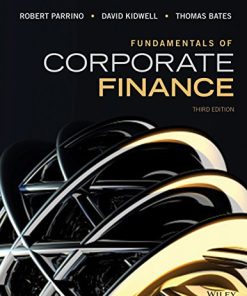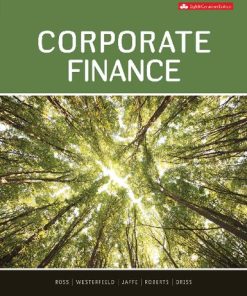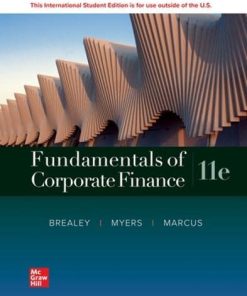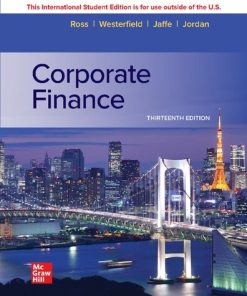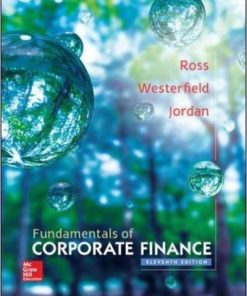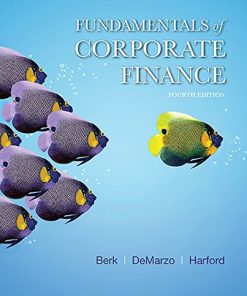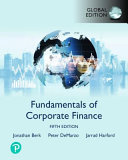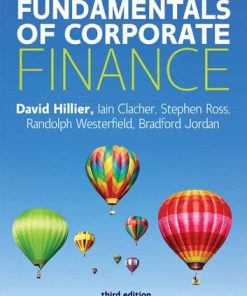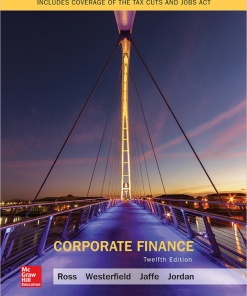(Ebook PDF) Fundamentals of Corporate Finance 13th Edition by Stephen Ross 1264250096 9781264250097 full chapters
$50.00 Original price was: $50.00.$25.00Current price is: $25.00.
Fundamentals of Corporate Finance 13th Edition by Stephen Ross – Ebook PDF Instant Download/DeliveryISBN: 1264250096, 9781264250097
Full download Fundamentals of Corporate Finance 13th Edition after payment.
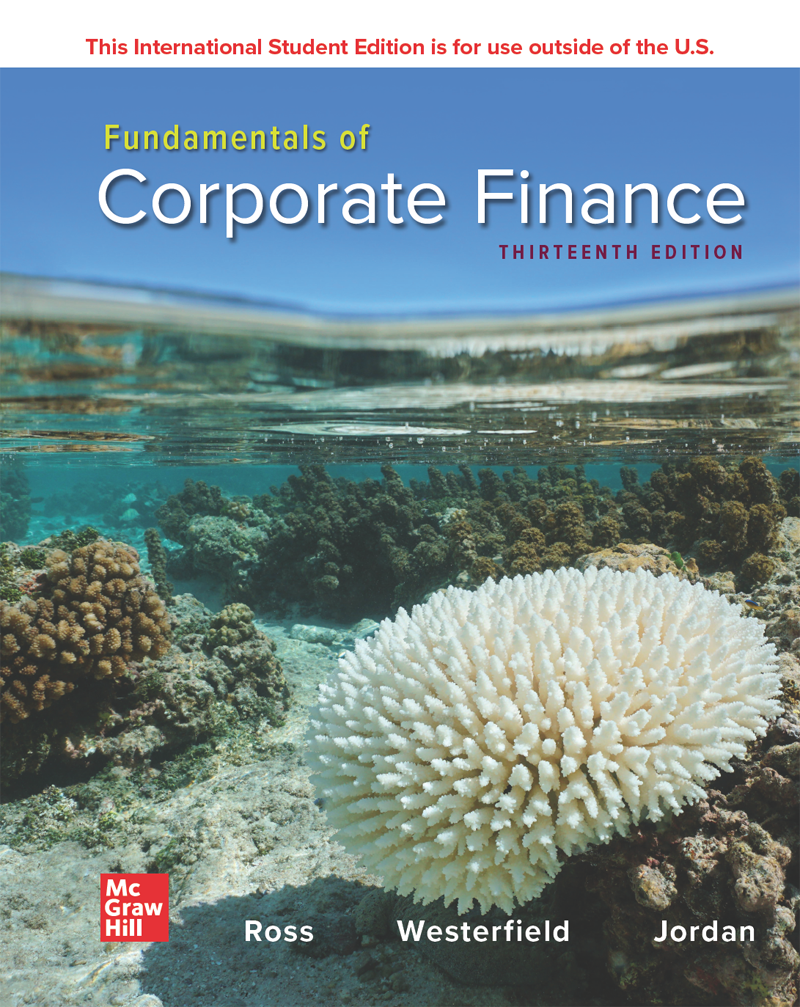
Product details:
ISBN-10 : 1264250096
ISBN-13 : 9781264250097
Author: Stephen Ross
Fundamentals of Corporate Finance
Fundamentals of Corporate Finance 13th Table of contents:
Chapter 1: Introduction to Corporate Finance
Chapter 1 Introduction
1.1 Finance: A Quick Look
FINANCE: THE FIVE MAIN AREAS
WHY STUDY FINANCE?
1.2 Corporate Finance and the Financial Manager
WHAT IS CORPORATE FINANCE?
THE FINANCIAL MANAGER
FINANCIAL MANAGEMENT DECISIONS
1.3 Forms of Business Organization
SOLE PROPRIETORSHIP
PARTNERSHIP
CORPORATION
A CORPORATION BY ANOTHER NAME . . .
BENEFIT CORPORATION
1.4 The Goal of Financial Management
POSSIBLE GOALS
THE GOAL OF FINANCIAL MANAGEMENT
A MORE GENERAL GOAL
SARBANES-OXLEY
1.5 The Agency Problem and Control of the Corporation
AGENCY RELATIONSHIPS
MANAGEMENT GOALS
DO MANAGERS ACT IN THE STOCKHOLDERS’ INTERESTS?
STAKEHOLDERS
1.6 Financial Markets and the Corporation
CASH FLOWS TO AND FROM THE FIRM
PRIMARY VERSUS SECONDARY MARKETS
1.7 Summary and Conclusions
Concepts Review and Critical Thinking Questions
Minicase
The McGee Cake Company
Chapter 2: Financial Statements, Taxes, and Cash Flow
Introduction
2.1 The Balance Sheet
ASSETS: THE LEFT SIDE
LIABILITIES AND OWNERS’ EQUITY: THE RIGHT SIDE
NET WORKING CAPITAL
LIQUIDITY
DEBT VERSUS EQUITY
MARKET VALUE VERSUS BOOK VALUE
2.2 The Income Statement
GAAP AND THE INCOME STATEMENT
NONCASH ITEMS
TIME AND COSTS
2.3 Taxes
CORPORATE TAX RATES
AVERAGE VERSUS MARGINAL TAX RATES
2.4 Cash Flow
CASH FLOW FROM ASSETS
CASH FLOW TO CREDITORS AND STOCKHOLDERS
AN EXAMPLE: CASH FLOWS FOR DOLE COLA
2.5 Summary and Conclusions
Chapter Review and Self-Test Problem
Answer to Chapter Review and Self-Test Problem
Concepts Review and Critical Thinking Questions
Questions and Problems
Excel Master It! Problem
Minicase
Cash Flows and Financial Statements at Sunset Boards, Inc.
Chapter 3: Working with Financial Statements
Introduction
3.1 Cash Flow and Financial Statements: A Closer Look
SOURCES AND USES OF CASH
THE STATEMENT OF CASH FLOWS
3.2 Standardized Financial Statements
COMMON-SIZE STATEMENTS
COMMON-BASE YEAR FINANCIAL STATEMENTS: TREND ANALYSIS
COMBINED COMMON-SIZE AND BASE YEAR ANALYSIS
3.3 Ratio Analysis
SHORT-TERM SOLVENCY, OR LIQUIDITY, MEASURES
LONG-TERM SOLVENCY MEASURES
ASSET MANAGEMENT, OR TURNOVER, MEASURES
PROFITABILITY MEASURES
MARKET VALUE MEASURES
CONCLUSION
3.4 The DuPont Identity
A CLOSER LOOK AT ROE
AN EXPANDED DUPONT ANALYSIS
3.5 Using Financial Statement Information
WHY EVALUATE FINANCIAL STATEMENTS?
CHOOSING A BENCHMARK
PROBLEMS WITH FINANCIAL STATEMENT ANALYSIS
3.6 Summary and Conclusions
Connect to Finance
Chapter Review and Self-Test Problems
Answers to Chapter Review and Self-Test Problems
Concepts Review and Critical Thinking Questions
Questions and Problems
Excel Master It! Problem
Minicase
Ratio Analysis at S&S Air, Inc.
Chapter 4: Long-Term Financial Planning and Growth
Chapter 4 Introduction
4.1 What Is Financial Planning?
GROWTH AS A FINANCIAL MANAGEMENT GOAL
DIMENSIONS OF FINANCIAL PLANNING
WHAT CAN PLANNING ACCOMPLISH?
4.2 Financial Planning Models: A First Look
A FINANCIAL PLANNING MODEL: THE INGREDIENTS
A SIMPLE FINANCIAL PLANNING MODEL
4.3 The Percentage of Sales Approach
THE INCOME STATEMENT
THE BALANCE SHEET
A PARTICULAR SCENARIO
AN ALTERNATIVE SCENARIO
4.4 External Financing and Growth
EFN AND GROWTH
FINANCIAL POLICY AND GROWTH
A NOTE ABOUT SUSTAINABLE GROWTH RATE CALCULATIONS
4.5 Some Caveats Regarding Financial Planning Models
4.6 Summary and Conclusions
Connect to Finance
Chapter Review and Self-Test Problems
Answers to Chapter Review and Self-Test Problems
Concepts Review and Critical Thinking Questions
Questions and Problems
Excel Master It! Problem
Minicase
Planning for Growth at S&S Air
Chapter 5: Introduction to Valuation: The Time Value of Money
Chapter 5 Introduction
5.1 Future Value and Compounding
INVESTING FOR A SINGLE PERIOD
INVESTING FOR MORE THAN ONE PERIOD
A NOTE ABOUT COMPOUND GROWTH
5.2 Present Value and Discounting
THE SINGLE-PERIOD CASE
PRESENT VALUES FOR MULTIPLE PERIODS
5.3 More about Present and Future Values
PRESENT VERSUS FUTURE VALUE
DETERMINING THE DISCOUNT RATE
FINDING THE NUMBER OF PERIODS
5.4 Summary and Conclusions
Connect to Finance
Chapter Review and Self-Test Problems
Answers to Chapter Review and Self-Test Problems
Concepts Review and Critical Thinking Questions
Questions and Problems
EXCEL MASTER IT! PROBLEMS
Chapter 6: Discounted Cash Flow Valuation
Chapter 6 Introduction
6.1 Future and Present Values of Multiple Cash Flows
FUTURE VALUE WITH MULTIPLE CASH FLOWS
PRESENT VALUE WITH MULTIPLE CASH FLOWS
A NOTE ABOUT CASH FLOW TIMING
6.2 Valuing Level Cash Flows: Annuities and Perpetuities
PRESENT VALUE FOR ANNUITY CASH FLOWS
FUTURE VALUE FOR ANNUITIES
A NOTE ABOUT ANNUITIES DUE
PERPETUITIES
GROWING ANNUITIES AND PERPETUITIES
6.3 Comparing Rates: The Effect of Compounding
EFFECTIVE ANNUAL RATES AND COMPOUNDING
CALCULATING AND COMPARING EFFECTIVE ANNUAL RATES
EARs AND APRs
TAKING IT TO THE LIMIT: A NOTE ABOUT CONTINUOUS COMPOUNDING
6.4 Loan Types and Loan Amortization
PURE DISCOUNT LOANS
INTEREST-ONLY LOANS
AMORTIZED LOANS
6.5 Summary and Conclusions
Connect to Finance
Chapter Review and Self-Test Problems
Answers to Chapter Review and Self-Test Problems
Concepts Review and Critical Thinking Questions
Questions and Problems
Excel Master-It! Problem
Minicase
The MBA Decision
Chapter 7: Interest Rates and Bond Valuation
Chapter 7 Introduction
7.1 Bonds and Bond Valuation
BOND FEATURES AND PRICES
BOND VALUES AND YIELDS
INTEREST RATE RISK
FINDING THE YIELD TO MATURITY: MORE TRIAL AND ERROR
7.2 More about Bond Features
IS IT DEBT OR EQUITY?
LONG-TERM DEBT: THE BASICS
THE INDENTURE
7.3 Bond Ratings
7.4 Some Different Types of Bonds
GOVERNMENT BONDS
ZERO COUPON BONDS
FLOATING-RATE BONDS
OTHER TYPES OF BONDS
SUKUK
7.5 Bond Markets
HOW BONDS ARE BOUGHT AND SOLD
BOND PRICE REPORTING
A NOTE ABOUT BOND PRICE QUOTES
7.6 Inflation and Interest Rates
REAL VERSUS NOMINAL RATES
THE FISHER EFFECT
INFLATION AND PRESENT VALUES
7.7 Determinants of Bond Yields
THE TERM STRUCTURE OF INTEREST RATES
BOND YIELDS AND THE YIELD CURVE: PUTTING IT ALL TOGETHER
CONCLUSION
7.8 Summary and Conclusions
Connect to Finance
Chapter Review and Self-Test Problems
Answers to Chapter Review and Self-Test Problems
Concepts Review and Critical Thinking Questions
Questions and Problems
Excel Master It! Problem
Minicase
FINANCING S&S AIR’S EXPANSION PLANS WITH A BOND ISSUE
Chapter 8: Stock Valuation
Chapter 8 Introduction
8.1 Common Stock Valuation
CASH FLOWS
SOME SPECIAL CASES
COMPONENTS OF THE REQUIRED RETURN
STOCK VALUATION USING MULTIPLES
8.2 Some Features of Common and Preferred Stocks
COMMON STOCK FEATURES
PREFERRED STOCK FEATURES
8.3 The Stock Markets
DEALERS AND BROKERS
ORGANIZATION OF THE NYSE
NASDAQ OPERATIONS
STOCK MARKET REPORTING
8.4 Summary and Conclusions
Connect to Finance
Chapter Review and Self-Test Problems
Answers to Chapter Review and Self-Test Problems
Concepts Review and Critical Thinking Questions
Questions and Problems
Excel Master It! Problem
Minicase
Stock Valuation at Ragan, Inc.
Chapter 9: Net Present Value and Other Investment Criteria
Chapter 9 Introduction
9.1 Net Present Value
THE BASIC IDEA
ESTIMATING NET PRESENT VALUE
9.2 The Payback Rule
DEFINING THE RULE
ANALYZING THE RULE
REDEEMING QUALITIES OF THE RULE
SUMMARY OF THE RULE
9.3 The Discounted Payback
9.4 The Average Accounting Return
9.5 The Internal Rate of Return
PROBLEMS WITH THE IRR
REDEEMING QUALITIES OF THE IRR
THE MODIFIED INTERNAL RATE OF RETURN (MIRR)
9.6 The Profitability Index
9.7 The Practice of Capital Budgeting
9.8 Summary and Conclusions
Connect to Finance
Chapter Review and Self-Test Problems
Answers to Chapter Review and Self-Test Problems
Concepts Review and Critical Thinking Questions
Questions and Problems
Excel Master It! Problem
Minicase
BULLOCK GOLD MINING
Chapter 10: Making Capital Investment Decisions
Chapter 10 Introduction
10.1 Project Cash Flows: A First Look
RELEVANT CASH FLOWS
THE STAND-ALONE PRINCIPLE
10.2 Incremental Cash Flows
SUNK COSTS
OPPORTUNITY COSTS
SIDE EFFECTS
NET WORKING CAPITAL
FINANCING COSTS
OTHER ISSUES
10.3 Pro Forma Financial Statements and Project Cash Flows
GETTING STARTED: PRO FORMA FINANCIAL STATEMENTS
PROJECT CASH FLOWS
PROJECTED TOTAL CASH FLOW AND VALUE
10.4 More about Project Cash Flow
A CLOSER LOOK AT NET WORKING CAPITAL
DEPRECIATION
AN EXAMPLE: THE MAJESTIC MULCH AND COMPOST COMPANY (MMCC)
10.5 Alternative Definitions of Operating Cash Flow
THE BOTTOM-UP APPROACH
THE TOP-DOWN APPROACH
THE TAX SHIELD APPROACH
CONCLUSION
10.6 Some Special Cases of Discounted Cash Flow Analysis
EVALUATING COST-CUTTING PROPOSALS
SETTING THE BID PRICE
EVALUATING EQUIPMENT OPTIONS WITH DIFFERENT LIVES
10.7 Summary and Conclusions
Connect to Finance
Chapter Review and Self-Test Problems
Answers to Chapter Review and Self-Test Problems
Concepts Review and Critical Thinking Questions
Questions and Problems
Excel Master It! Problem
Minicase
Conch Republic Electronics, Part 1
Chapter 11: Project Analysis and Evaluation
Chapter 11 Introduction
11.1 Evaluating NPV Estimates
THE BASIC PROBLEM
PROJECTED VERSUS ACTUAL CASH FLOWS
FORECASTING RISK
SOURCES OF VALUE
11.2 Scenario and Other What-If Analyses
GETTING STARTED
SCENARIO ANALYSIS
SENSITIVITY ANALYSIS
SIMULATION ANALYSIS
11.3 Break-Even Analysis
FIXED AND VARIABLE COSTS
ACCOUNTING BREAK-EVEN
ACCOUNTING BREAK-EVEN: A CLOSER LOOK
USES FOR THE ACCOUNTING BREAK-EVEN
11.4 Operating Cash Flow, Sales Volume, and Break-Even
ACCOUNTING BREAK-EVEN AND CASH FLOW
SALES VOLUME AND OPERATING CASH FLOW
CASH FLOW, ACCOUNTING, AND FINANCIAL BREAK-EVEN POINTS
11.5 Operating Leverage
THE BASIC IDEA
IMPLICATIONS OF OPERATING LEVERAGE
MEASURING OPERATING LEVERAGE
OPERATING LEVERAGE AND BREAK-EVEN
11.6 Capital Rationing
SOFT RATIONING
HARD RATIONING
11.7 Summary and Conclusions
Connect to Finance
Chapter Review and Self-Test Problems
Answers to Chapter Review and Self-Test Problems
Concepts Review and Critical Thinking Questions
Questions and Problems
Excel Master It! Problem
Minicase
Conch Republic Electronics, Part 2
Chapter 12: Some Lessons from Capital Market History
Chapter 12 Introduction
12.1 Returns
DOLLAR RETURNS
PERCENTAGE RETURNS
12.2 The Historical Record
A FIRST LOOK
A CLOSER LOOK
12.3 Average Returns: The First Lesson
CALCULATING AVERAGE RETURNS
AVERAGE RETURNS: THE HISTORICAL RECORD
RISK PREMIUMS
THE FIRST LESSON
12.4 The Variability of Returns: The Second Lesson
FREQUENCY DISTRIBUTIONS AND VARIABILITY
THE HISTORICAL VARIANCE AND STANDARD DEVIATION
THE HISTORICAL RECORD
NORMAL DISTRIBUTION
THE SECOND LESSON
2008: A YEAR TO REMEMBER
USING CAPITAL MARKET HISTORY
MORE ON THE STOCK MARKET RISK PREMIUM
12.5 More about Average Returns
ARITHMETIC VERSUS GEOMETRIC AVERAGES
CALCULATING GEOMETRIC AVERAGE RETURNS
ARITHMETIC AVERAGE RETURN OR GEOMETRIC AVERAGE RETURN?
12.6 Capital Market Efficiency
PRICE BEHAVIOR IN AN EFFICIENT MARKET
THE EFFICIENT MARKETS HYPOTHESIS
SOME COMMON MISCONCEPTIONS ABOUT THE EMH
THE FORMS OF MARKET EFFICIENCY
12.7 Summary and Conclusions
Connect to Finance
Chapter Review and Self-Test Problems
Answers to Chapter Review and Self-Test Problems
Concepts Review and Critical Thinking Questions
Questions and Problems
Excel Master It! Problem
Minicase
A JOB AT S&S AIR
Chapter 13: Return, Risk, and the Security Market Line
Chapter 13 Introduction
13.1 Expected Returns and Variances
EXPECTED RETURN
CALCULATING THE VARIANCE
13.2 Portfolios
PORTFOLIO WEIGHTS
PORTFOLIO EXPECTED RETURNS
PORTFOLIO VARIANCE
13.3 Announcements, Surprises, and Expected Returns
EXPECTED AND UNEXPECTED RETURNS
ANNOUNCEMENTS AND NEWS
13.4 Risk: Systematic and Unsystematic
SYSTEMATIC AND UNSYSTEMATIC RISK
SYSTEMATIC AND UNSYSTEMATIC COMPONENTS OF RETURN
13.5 Diversification and Portfolio Risk
THE EFFECT OF DIVERSIFICATION: ANOTHER LESSON FROM MARKET HISTORY
THE PRINCIPLE OF DIVERSIFICATION
DIVERSIFICATION AND UNSYSTEMATIC RISK
DIVERSIFICATION AND SYSTEMATIC RISK
13.6 Systematic Risk and Beta
THE SYSTEMATIC RISK PRINCIPLE
MEASURING SYSTEMATIC RISK
PORTFOLIO BETAS
13.7 The Security Market Line
BETA AND THE RISK PREMIUM
THE SECURITY MARKET LINE
13.8 The SML and the Cost of Capital: A Preview
THE BASIC IDEA
THE COST OF CAPITAL
13.9 Summary and Conclusions
Connect to Finance
Chapter Review and Self-Test Problems
Answers to Chapter Review and Self-Test Problems
Concepts Review and Critical Thinking Questions
Questions and Problems
Excel Master It! Problem
Minicase
The Beta for Colgate-Palmolive
Chapter 14: Cost of Capital
Chapter 14 Introduction
14.1 The Cost of Capital: Some Preliminaries
REQUIRED RETURN VERSUS COST OF CAPITAL
FINANCIAL POLICY AND COST OF CAPITAL
14.2 The Cost of Equity
THE DIVIDEND GROWTH MODEL APPROACH
THE SML APPROACH
14.3 The Costs of Debt and Preferred Stock
THE COST OF DEBT
THE COST OF PREFERRED STOCK
14.4 The Weighted Average Cost of Capital
THE CAPITAL STRUCTURE WEIGHTS
TAXES AND THE WEIGHTED AVERAGE COST OF CAPITAL
CALCULATING THE WACC FOR EASTMAN CHEMICAL
SOLVING THE WAREHOUSE PROBLEM AND SIMILAR CAPITAL BUDGETING PROBLEMS
PERFORMANCE EVALUATION: ANOTHER USE OF THE WACC
14.5 Divisional and Project Costs of Capital
THE SML AND THE WACC
DIVISIONAL COST OF CAPITAL
THE PURE PLAY APPROACH
THE SUBJECTIVE APPROACH
14.6 Company Valuation with the WACC
14.7 Flotation Costs and the Average Cost of Capital
THE BASIC APPROACH
FLOTATION COSTS AND NPV
INTERNAL EQUITY AND FLOTATION COSTS
14.8 Summary and Conclusions
Connect to Finance
Chapter Review and Self-Test Problems
Answers to Chapter Review and Self-Test Problems
Concepts Review and Critical Thinking Questions
Questions and Problems
Excel Master It! Problem
Minicase
Cost of Capital for Master Tools
Chapter 15: Raising Capital
Chapter 15 Introduction
15.1 Entrepreneurship: Early-Stage Financing and Venture Capital
ENTREPRENEURSHIP
VENTURE CAPITAL
SOME VENTURE CAPITAL REALITIES
VENTURE CAPITAL FIRMS
CROWDFUNDING
INITIAL COIN OFFERINGS (ICOS)
CONCLUSION
15.2 Selling Securities to the Public: The Basic Procedure
15.3 Alternative Issue Methods
15.4 Underwriters
CHOOSING AN UNDERWRITER
TYPES OF UNDERWRITING
THE AFTERMARKET
THE GREEN SHOE PROVISION
LOCKUP AGREEMENTS
THE QUIET PERIOD
DIRECT LISTING
15.5 IPOs and Underpricing
IPO UNDERPRICING: THE 1999–2000 EXPERIENCE
EVIDENCE ON UNDERPRICING
THE PARTIAL ADJUSTMENT PHENOMENON
WHY DOES UNDERPRICING EXIST?
15.6 New Equity Sales and the Value of the Firm
15.7 The Costs of Issuing Securities
THE COSTS OF SELLING STOCK TO THE PUBLIC
THE COSTS OF GOING PUBLIC: A CASE STUDY
15.8 Rights
THE MECHANICS OF A RIGHTS OFFERING
NUMBER OF RIGHTS NEEDED TO PURCHASE A SHARE
THE VALUE OF A RIGHT
EX RIGHTS
THE UNDERWRITING ARRANGEMENTS
EFFECTS ON SHAREHOLDERS
15.9 Dilution
DILUTION OF PROPORTIONATE OWNERSHIP
DILUTION OF VALUE: BOOK VERSUS MARKET VALUES
15.10 Issuing Long-Term Debt
15.11 Shelf Registration
15.12 Summary and Conclusions
Connect to Finance
Chapter Review and Self-Test Problems
Answers to Chapter Review and Self-Test Problems
Concepts Review and Critical Thinking Questions
Questions and Problems
Minicase
S&S Air Goes Public
Chapter 16: Financial Leverage and Capital Structure Policy
Chapter 16 Introduction
16.1 The Capital Structure Question
FIRM VALUE AND STOCK VALUE: AN EXAMPLE
CAPITAL STRUCTURE AND THE COST OF CAPITAL
16.2 The Effect of Financial Leverage
THE BASICS OF FINANCIAL LEVERAGE
CORPORATE BORROWING AND HOMEMADE LEVERAGE
16.3 Capital Structure and the Cost of Equity Capital
M&M PROPOSITION I: THE PIE MODEL
THE COST OF EQUITY AND FINANCIAL LEVERAGE: M&M PROPOSITION II
BUSINESS AND FINANCIAL RISK
16.4 M&M Propositions I and II with Corporate Taxes
THE INTEREST TAX SHIELD
TAXES AND M&M PROPOSITION I
TAXES, THE WACC, AND PROPOSITION II
CONCLUSION
16.5 Bankruptcy Costs
DIRECT BANKRUPTCY COSTS
INDIRECT BANKRUPTCY COSTS
16.6 Optimal Capital Structure
THE STATIC THEORY OF CAPITAL STRUCTURE
OPTIMAL CAPITAL STRUCTURE AND THE COST OF CAPITAL
OPTIMAL CAPITAL STRUCTURE: A RECAP
CAPITAL STRUCTURE: SOME MANAGERIAL RECOMMENDATIONS
16.7 The Pie Again
THE EXTENDED PIE MODEL
MARKETED CLAIMS VERSUS NONMARKETED CLAIMS
16.8 The Pecking-Order Theory
INTERNAL FINANCING AND THE PECKING ORDER
IMPLICATIONS OF THE PECKING ORDER
16.9 Observed Capital Structures
16.10 A Quick Look at the Bankruptcy Process
LIQUIDATION AND REORGANIZATION
FINANCIAL MANAGEMENT AND THE BANKRUPTCY PROCESS
AGREEMENTS TO AVOID BANKRUPTCY
16.11 Summary and Conclusions
Connect to Finance
Chapter Review and Self-Test Problems
Answers to Chapter Review and Self-Test Problems
Concepts Review and Critical Thinking Questions
Questions and Problems
Excel Master It! Problem
Minicase
Stephenson Real Estate Recapitalization
Chapter 17: Dividends and Payout Policy
Chapter 17 Introduction
17.1 Cash Dividends and Dividend Payment
CASH DIVIDENDS
STANDARD METHOD OF CASH DIVIDEND PAYMENT
DIVIDEND PAYMENT: A CHRONOLOGY
MORE ABOUT THE EX-DIVIDEND DATE
17.2 Does Dividend Policy Matter?
AN ILLUSTRATION OF THE IRRELEVANCE OF DIVIDEND POLICY
HOMEMADE DIVIDENDS
A TEST
17.3 Real-World Factors Favoring a Low Dividend Payout
TAXES
FLOTATION COSTS
DIVIDEND RESTRICTIONS
17.4 Real-World Factors Favoring a High Dividend Payout
DESIRE FOR CURRENT INCOME
TAX AND OTHER BENEFITS FROM HIGH DIVIDENDS
CONCLUSION
17.5 A Resolution of Real-World Factors?
INFORMATION CONTENT OF DIVIDENDS
THE CLIENTELE EFFECT
17.6 Stock Repurchases: An Alternative to Cash Dividends
CASH DIVIDENDS VERSUS REPURCHASE
REAL-WORLD CONSIDERATIONS IN A REPURCHASE
SHARE REPURCHASE AND EPS
17.7 What We Know and Do Not Know about Dividend and Payout Policies
DIVIDENDS AND DIVIDEND PAYERS
CORPORATIONS SMOOTH DIVIDENDS
PUTTING IT ALL TOGETHER
SOME SURVEY EVIDENCE ON DIVIDENDS
17.8 Stock Dividends and Stock Splits
SOME DETAILS ABOUT STOCK SPLITS AND STOCK DIVIDENDS
VALUE OF STOCK SPLITS AND STOCK DIVIDENDS
REVERSE SPLITS
17.9 Summary and Conclusions
Connect to Finance
Concepts Review and Critical Thinking Questions
Questions and Problems
Minicase
Electronic Timing, Inc.
Chapter 18: Short-Term Finance and Planning
Chapter 18 Introduction
18.1 Tracing Cash and Net Working Capital
18.2 The Operating Cycle and the Cash Cycle
DEFINING THE OPERATING AND CASH CYCLES
THE OPERATING CYCLE AND THE FIRM’S ORGANIZATIONAL CHART
CALCULATING THE OPERATING AND CASH CYCLES
INTERPRETING THE CASH CYCLE
18.3 Some Aspects of Short-Term Financial Policy
THE SIZE OF THE FIRM’S INVESTMENT IN CURRENT ASSETS
ALTERNATIVE FINANCING POLICIES FOR CURRENT ASSETS
WHICH FINANCING POLICY IS BEST?
CURRENT ASSETS AND LIABILITIES IN PRACTICE
18.4 The Cash Budget
SALES AND CASH COLLECTIONS
CASH OUTFLOWS
THE CASH BALANCE
18.5 Short-Term Borrowing
UNSECURED LOANS
SECURED LOANS
OTHER SOURCES
18.6 A Short-Term Financial Plan
18.7 Summary and Conclusions
Connect to Finance
Chapter Review and Self-Test Problems
Answers to Chapter Review and Self-Test Problems
Concepts Review and Critical Thinking Questions
Questions and Problems
Excel Master It! Problems
Minicase
Piepkorn Manufacturing Working Capital Management
Chapter 19: Cash and Liquidity Management
Chapter 19 Introduction
19.1 Reasons for Holding Cash
THE SPECULATIVE AND PRECAUTIONARY MOTIVES
THE TRANSACTION MOTIVE
COMPENSATING BALANCES
COSTS OF HOLDING CASH
CASH MANAGEMENT VERSUS LIQUIDITY MANAGEMENT
19.2 Understanding Float
DISBURSEMENT FLOAT
COLLECTION FLOAT AND NET FLOAT
FLOAT MANAGEMENT
ELECTRONIC DATA INTERCHANGE AND CHECK 21: THE END OF FLOAT?
19.3 Cash Collection and Concentration
COMPONENTS OF COLLECTION TIME
CASH COLLECTION
LOCKBOXES
CASH CONCENTRATION
ACCELERATING COLLECTIONS: AN EXAMPLE
19.4 Managing Cash Disbursements
INCREASING DISBURSEMENT FLOAT
CONTROLLING DISBURSEMENTS
19.5 Investing Idle Cash
TEMPORARY CASH SURPLUSES
CHARACTERISTICS OF SHORT-TERM SECURITIES
SOME DIFFERENT TYPES OF MONEY MARKET SECURITIES
19.6 Summary and Conclusions
Connect to Finance
Chapter Review and Self-Test Problem
Answers to Chapter Review and Self-Test Problem
Concepts Review and Critical Thinking Questions
Questions and Problems
Minicase
Cash Management at Webb Corporation
19A Determining the Target Cash Balance
THE BASIC IDEA
THE BAT MODEL
THE MILLER-ORR MODEL: A MORE GENERAL APPROACH
IMPLICATIONS OF THE BAT AND MILLER-ORR MODELS
OTHER FACTORS INFLUENCING THE TARGET CASH BALANCE
Appendix Review and Self-Test Problem
Answers to Appendix Review and Self-Test Problems
Questions and Problems
People also search for Fundamentals of Corporate Finance 13th:
fundamentals of corporate finance 11th edition
fundamentals of corporate finance 2024 release
fundamentals of corporate finance 5th edition
fundamentals of corporate finance 6th edition
fundamentals of corporate finance 12th edition
Tags:
Fundamentals,Corporate Finance,Stephen Ross,
You may also like…
Business & Economics
Business & Economics Business & Economics - Professional Finance
Uncategorized
Business & Economics - Professional Finance
Business & Economics - Accounting




